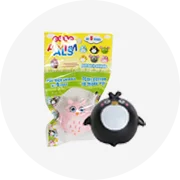Popular in your industry







































































Top categories
About robo light
In an era where technology continuously redefines the boundaries of possibility, the advent of robo light innovations stands as a testament to human ingenuity. This ultimate guide illuminates the transformative impact of robotic lighting technology in various domains, from industrial efficiency to interactive entertainment. As we delve into the world of robo lights, we'll explore how these advancements are not just brightening spaces but revolutionizing them, offering unprecedented precision, adaptability, and intelligence to lighting systems. Join us as we shed light on the future of illumination and its role in shaping the environments of tomorrow.
Understanding Robo Light Innovations

Robotic lighting technology has advanced to a point where it significantly enhances the precision and efficiency of industrial tasks. The integration of area cameras with specialized lighting allows for a well-illuminated workspace. These lighting solutions are designed to provide consistent brightness over a wide area, ensuring that even if workpiece positions vary, the visibility remains clear for accurate camera capture and stable system operation.
Another innovation in robotic lighting assists robotic arms in accurately picking parts from palettes. These lights are capable of illuminating a large area, covering a standard palette, and can operate effectively over a range of distances. This capability allows for the use of a single LED light source to cover a wide area, which can contribute to equipment downsizing and cost reduction.
Advancements in ring lighting technology offer brightness that exceeds conventional models without the need for strobe overdrive power supplies. These lights can remain on for an extended duration, which simplifies synchronization with camera shutters, facilitating easier integration into robotic vision and appearance inspection systems.
Types of Robo Lights Available on Alibaba.com

Alibaba.com showcases a diverse array of Robo Lights, catering to various preferences and applications. The selection includes interactive toys for kids that combine entertainment with education, and professional lighting designed for entertainment venues. For those seeking innovative lighting solutions, the platform offers portable party lights with RGB and 3D effects, as well as autonomous delivery robots, which serve practical purposes in schools or hospitals.
The range extends to specialized lighting equipment ideal for enhancing the ambiance in nightclubs, and various models suitable for creating dynamic lighting effects for events and parties. For children's entertainment, there are options like electric dance robots and interactive flashing light musical toys, which are designed to captivate and engage young minds.
Robo Lights on Alibaba.com also include stage effects and entertainment lighting such as moving head beam lights and laser projectors, which are essential for creating a memorable visual experience in performance settings. Additionally, educational and interactive toys combine learning with fun, featuring music and light effects that encourage children's cognitive development.
Industrial Applications of Robotic Lighting
Robotic lighting plays a pivotal role in industrial automation, enhancing the capabilities of machine vision systems. These advanced lighting solutions are integral to applications such as multispectral imaging, where they enable the inspection of food quality, determining ripeness of fruit, or analyzing the content in meat. The flexibility of robotic lighting systems allows for their use in diverse environments, adapting to the specific needs of various tasks.
In the realm of collaborative robots, or cobots, robotic lighting is essential. Cobots, designed to work alongside humans, require precise lighting to perform tasks such as machine tending, material handling, and quality inspection. The integration of multifunctional lighting units with cobots facilitates complex assembly and inspection tasks, providing the necessary illumination for high-resolution imaging and photometric stereo techniques.
The importance of lighting extends to deep learning applications within industrial settings. Quality lighting is crucial for creating high-quality datasets necessary for training deep learning models. Proper lighting ensures sufficient contrast for image capture, which is fundamental for the accuracy of deep learning algorithms in tasks like optical character recognition and defect detection in electronics and semiconductor inspection.
Key Features and Technologies in Robo Lighting
Smart lighting technology, a component of smart home systems, is advancing into the realm of robotics with innovations like robo lights. These sophisticated lighting solutions incorporate features such as remote control via mobile apps or voice-activated assistants, and condition-based IFTTT (If This Then That) technology, allowing for a high degree of customization and automation. Robo lights can adapt their operations based on user-set schedules, occupancy, or even specific events, contributing to energy savings and enhanced user convenience.
The communication technologies underpinning these systems are diverse, including Wi-Fi, which connects lights to the internet allowing for remote operation. Bluetooth-enabled lights can form a mesh network, manageable via BLE-enabled devices, though a hub is often required for internet connectivity. Similarly, ZigBee and Z-Wave technologies enable the creation of a networked lighting system, which also requires a hub to facilitate control. These technologies ensure that robo lights can be integrated seamlessly into existing smart home ecosystems.
Robo lights are also equipped with sensors, such as PIR for motion detection, enabling them to respond dynamically to the environment. For instance, lights can activate when motion is detected, providing illumination precisely when and where it's needed. This intelligent functionality not only improves the user experience but also contributes to the system's energy efficiency by reducing unnecessary power consumption.
Material and Design Considerations for Robo Lights

The innovative materials used in the development of robo lights are pivotal to their functionality and design. A notable example is the use of photonic crystals, which are integral to the light-activation of these devices. These crystals, often embedded in films, are engineered to respond to light, enabling the robo lights to execute movements or form complex shapes autonomously. The interaction of light with these materials results in precise control over the movement of the robo lights, as they can bend, twist, and fold in response to the light's direction and intensity.
In the realm of material science, the combination of substances like silk fibroin doped with gold nanoparticles and silicon-based polymers such as polydimethylsiloxane (PDMS) exemplifies the advanced design considerations for robo lights. Silk fibroin's unique property of contracting when heated and PDMS's rapid expansion in response to heat allows for a dynamic interaction when exposed to light. This differential in thermal expansion rates between the layers causes the material to actuate without the need for external power sources.
The design process often involves patterning the photonic crystal films to dictate how they absorb and reflect light. By altering these patterns, it's possible to fine-tune the material's reactions, resulting in a variety of movements and configurations when illuminated. This level of design intricacy underscores the potential for creating highly responsive and adaptive lighting systems that can transform the way we utilize light in industrial and commercial spaces.
Advantages of Integrating Robo Lights into Your Space
The integration of robotic vision systems into industrial spaces offers significant advantages. These systems enhance the dynamic capabilities of robots, allowing them to adapt to variations in their operational environment. This adaptability means that robots equipped with vision systems are not limited to rigid, pre-programmed paths and can accommodate minor deviations, which helps maintain continuous production flow.
Robotic vision systems, particularly those with 3D capabilities, have revolutionized the way robots perceive their surroundings, making them more efficient and reducing the need for exact positioning of parts. This flexibility results in a more streamlined operation, as robots can perform tasks with greater accuracy and even conduct in-process inspections to ensure quality control.
The use of these advanced vision systems in robotic lighting or 'robo lights' translates into a more flexible automation solution. By reducing the costs associated with implementing and operating industrial robots, businesses can improve their overall performance and productivity, leveraging the latest in 3D vision technology to stay ahead in competitive markets.
Installation and Maintenance: What to Expect
When integrating robo lights into your system, the installation process involves precise wiring and secure connections to ensure optimal performance. The initial step requires preparing a base for the control system, typically using a sturdy material like plywood. Layout the core components, adhering to the example layout provided, and fasten them securely to the base. Given the potential for substantial contact in dynamic environments, it's advisable to use robust fastening methods such as nut and bolt fasteners or cable ties.
The wiring process includes attaching the robot side battery connector using specific tools like a Wago tool or a small flat-head screwdriver. It's crucial to use the correct wire gauge and to strip the wire ends to the recommended length for a reliable connection. When connecting wires to the power distribution hub, ensure that they are not tinned or twisted to maximize pullout force and minimize resistance.
For motor controller power, both integrated wire controllers and terminal motor controllers require careful cutting, stripping, and insertion into the appropriate Wago terminals. The connections should be insulated with electrical tape to prevent short circuits. Regular maintenance checks are essential to ensure all connections remain secure and the system functions as expected.
Case Studies: Success Stories with Alibaba.com’s Robo Lights
How to Choose the Right Robo Light for Your Business
Conclusion
Robo light innovations represent a significant leap forward in the way we think about and utilize lighting. From the precision-enhanced capabilities of industrial robotic systems to the interactive and educational toys available on platforms like Alibaba.com, these technologies are reshaping our approach to lighting. The integration of advanced materials and design considerations allows for a new level of responsiveness and adaptability in commercial and industrial settings. Moreover, the practical advantages of robo lights in terms of flexibility, cost-efficiency, and productivity underscore their value in maintaining a competitive edge. As we have seen, the installation and maintenance of these systems are straightforward, ensuring that businesses can easily adopt this cutting-edge technology. In conclusion, robo lights are not just an investment in lighting; they are an investment in a smarter, more efficient, and more dynamic future for industries and entertainment spaces alike.



























